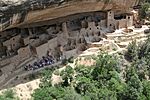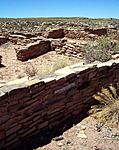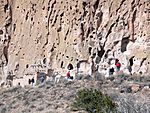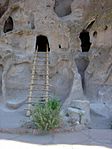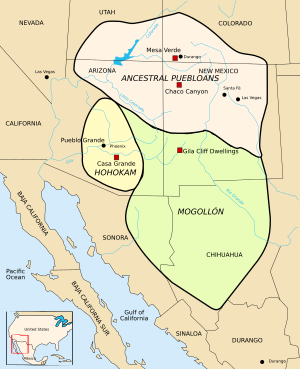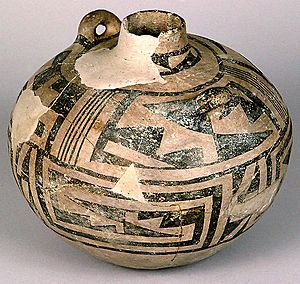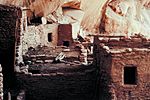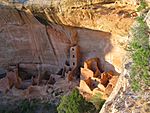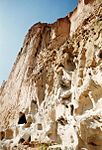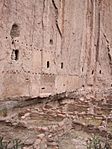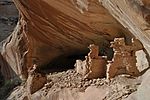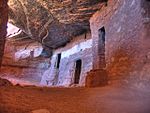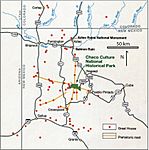Pueblo III Period facts for kids
The Pueblo III Period (from about 1150 to 1350 AD) was a time when the Ancestral Puebloans lived in huge communities. They built amazing homes, often high up in cliffs or as large, multi-story villages called pueblos. This period is also known as the "Great Pueblo Period" because of these impressive buildings. By the end of this time, many of these ancient people moved south from the Four Corners region. They settled in bigger pueblos in central and southern Arizona and New Mexico.
This period is part of a way archaeologists classify ancient cultures, called the Pecos Classification. It came after the Pueblo II Period and before the Pueblo IV Period.
Contents
Amazing Homes: Architecture of the Pueblo III Period
During the Pueblo III Period, most people lived in large communities with many stories. Some built their homes in canyon areas, like Sand Canyon and Goodman Point. Others chose to live in cliff dwellings on canyon ledges, such as those at Mesa Verde National Park or Keet Seel in the Navajo National Monument. These villages often had special round rooms called kivas, tall towers, and homes made from carefully stacked stones. A cool feature that appeared during this time was T-shaped windows and doors.
- Cliff Dwellings: These homes were built inside shallow caves and under rock overhangs along canyon walls. At Mesa Verde, the buildings were made from sandstone blocks and adobe mud. At Bandelier, people carved their homes right into the soft rock of the cliffs. Building these homes was a lot of work! Materials like stones and mud had to be carried up to the caves. The builders became very skilled, shaping stones smoothly. Walls were made thick to support many floors. The best caves faced south or southwest to catch the warm winter sun. Doors were small, sometimes covered with stone slabs to keep warm. Often, the first floor had no outside doors; people used ladders through holes in the ceilings to get in. Open areas in front of the homes were busy places where women ground corn and made clothes, while men made tools and children played.
- Surface Stone Buildings: Not everyone lived in cliffs. Many people built large, multi-family homes on the canyon rims and slopes. These grew very big as more people moved in.
- Talus Houses: These homes were built at the bottom of cliffs, often in front of carved-out cave rooms called "cavates." These rooms were made by scooping out soft rock.
-
Cliff Palace at Mesa Verde National Park
-
Walls of Puerco Pueblo, with up to 125 rooms, at Petrified Forest National Park
Communities and Settlements
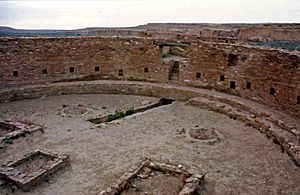
Three main areas with cliff dwellings and community centers were Chaco Culture National Historical Park in New Mexico, Mesa Verde National Park in Colorado, and the Betatakin and Keet Seel areas (Navajo National Monument) in Arizona.
- Bandelier: Here, the soft volcanic rock in cliff caves was scooped out to make space for stone homes. People used logs from juniper and pinyon trees to build frames for ceilings and upper floors, covering them with sticks, grass, bark, and earth.
- Mesa Verde: A typical cliff dwelling called Mug House was home to about 100 people. They shared 94 small rooms and eight kivas. Builders made the most of the space by putting rooms very close together. The population in the Mesa Verde Region grew to more than 20,000 people around 1200 to 1250 AD.
- Cowboy Wash: This archaeological site in Colorado was home to people from the Chuska Mountains area. They moved north after the Chaco culture faced problems due to a big drought from 1130–1180 AD. Excavations at Cowboy Wash showed signs of violent conflict between 1125–1150 AD, after which the sites were abandoned. The reasons for this violence are not fully clear, but it was a very rare event for the Ancestral Puebloans. It might have been caused by starvation during the drought or conflicts with outsiders.
Culture and Beliefs
- The People: The ancient people were generally shorter than people today. Men were about 5 feet 4 inches tall, and women were a few inches shorter. Women often died young, between 20 and 25 years old. Men usually lived to be 31 to 35. Many people had arthritis by age 29. Very few lived past 40.
It is believed that these communities were organized into clans, or groups of related families, with family lines traced through the mother (called matrilineal descent). When a couple married, they lived with the wife's mother. The husband would take part in religious activities in the kiva of his own mother's clan.
During the Pueblo III period, some people were buried with special objects. This suggests that some individuals had higher status in the community and that their religious beliefs were becoming more complex.
- Religious Life: The large number of family and "great" kivas, along with ceremonial objects and altars, shows how important spiritual life was. Kivas, usually used by men, were for religious rituals, social gatherings, and weaving. They were typically built underground with a fire pit, an opening in the ceiling for entry, a small hole called a Sipapu (for spirits), seating benches, and a ventilation shaft. Sometimes, nearby kivas were connected by tunnels. "Great" kivas were built for larger community events. Some kivas, like the Fire Temple at Mesa Verde, had painted images of people, plants, animals, and designs. These designs are similar to the ceremonial rooms of the modern Hopi people.
It is likely that public dances were performed to ask for good harvests, health, successful hunting, and rain, much like the Hopi Snake Dance. Everyone had a role in these ceremonies, and their responsibilities and status grew over time.
- Wall Art: Carved images called petroglyphs and painted images called pictographs are found on cliffs, buildings, and boulders. These designs often showed animals, people, plants, and geometric shapes. Hovenweep National Monument had two amazing kiva wall murals from this period, which are now kept at the Anasazi Heritage Center.
Farming and Food
To grow more food, the Pueblo III period saw new ways to save water. Stones were placed in and around farm fields to guide water for irrigation and reduce water run-off. They used bordered gardens, reservoirs, small dams, and terraced gardening plots. These methods built upon techniques from the Pueblo II Period. They grew corn, beans, and squash using dryland farming (farming without irrigation). Their diet was also helped by wild plants, like beeweed. When the soil became tired from too much farming, they found and cleared new land.
Pottery and Tools
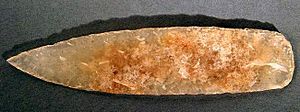
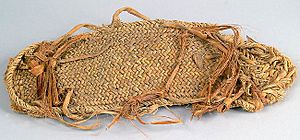
At the start of this period, people commonly made gray cooking and storage pots with wavy patterns. They also made black-on-white pottery with designs of geometric shapes, people, animals, and birds. They made many types of pots, including cooking pots, jars, mugs, bowls, pitchers, and ladles. Pottery making became a special skill, and some people made unique styles for trading. Towards the end of the period, they started making polychrome pottery, which means it had many colors like white, orange, red, and black.
The pottery from Mesa Verde and Chaco Canyon from this time is considered some of the best ancient pottery in the world.
Other Important Items
Here are some other things the people used during this period:
- Stone Tools: Men collected hard stones from mountains, river beds, or boulders to make tools:
- axes for cutting trees
- hammerstones for shaping sandstone blocks
- projectile points for bow and arrow hunting
- knives to cut plants and animal hides
- manos and metates for grinding corn, plants, nuts, and seeds.
- Bone Tools: Bones from deer, sheep, rabbits, and other animals were shaped into tools. These included stitching awls for making clothes, working hides, and weaving. Bones were also used as scrapers.
- Yucca: This plant, which grows well in dry areas, was used for many household items. Its strong fibers were used for sewing, ropes, and woven into blankets, clothing, sandals, and baskets. Its sharp points were used as needles or paint brushes. Yucca was also used as soap and even as food.
- Cotton Cloth: Cotton was obtained through trading. Men dyed it and wove it into cloth for clothing.
- Stone and Shell Ornaments: Jewelry and other decorations were made from shells and stones traded from the coasts of Mexico and California. Within their own region, they traded for turquoise, soapstone, and lignite. Just like their pottery, the shell and turquoise inlay work from this period was very artistic and well-known.
- Other Traded Items: Besides cotton, shells, and stones, the people of the Pueblo III period also traded for cloth, salt, and different types of pottery.
The Great Migration
By the year 1300, the Ancient Pueblo People living in the Four Corners region left their settlements. This big move was probably due to a long drought from 1276 to 1299 AD. This drought would have caused huge problems like starvation, attacks from hungry neighbors, and a big drop in the population. During and after the drought, there was a mass exodus (a large movement of people) south to central and southern Arizona and New Mexico.
There are other ideas about why people left the northern pueblo regions forever. The soil might have lost its nutrients from many years of farming. Or there might have been wars with other tribes in the area.
Cultural Groups of the Period
The main cultural groups during this time included:
- Ancestral Puebloans – found in southern Utah, southern Colorado, northern Arizona, and northern and central New Mexico.
- Hohokam – found in southern Arizona.
- Mogollon – found in southeastern Arizona, southern New Mexico, and northern Mexico.
- Patayan – found in western Arizona, California, and Baja California.
Important Pueblo III Sites
| Arizona | Colorado | New Mexico | Utah |
|---|---|---|---|
| Bailey Ruin Canyon de Chelly Case Grande Cohonina Glen Canyon Grand Canyon Mesa Grande Navajo Pueblos Oraibi |
Canyons of the Ancients Chimney Rock Hawkins Pueblo Hovenweep La Plata River valley Mesa Verde Ute Mountain Yucca House |
Aztec Ruins Bandelier Chaco Canyon Gila Cliff Dwellings Pecos area Puye Cliff Dwellings |
Alkali Ridge Comb Ridge Glen Canyon Hovenweep |
Images for kids
-
White House ruins in Canyon de Chelly National Monument
-
Keet Seel cliff dwellings at Navajo National Monument
-
Overhead view of Square Tower House at Mesa Verde National Park
-
Nankoweap ruins, Grand Canyon National Park in Arizona
-
Cliffs at Bandelier National Monument in New Mexico
-
Houses at Bandelier National Monument in New Mexico
-
Interior of cliff dwellings at Gila Cliff Dwellings National Monument
-
Monarch Cave Ruin at Comb Ridge, Utah
-
Lowry Pueblo in southwestern Colorado
-
Hovenweep Castle at Hovenweep National Monument
-
Moon House on Cedar Mesa in Utah



